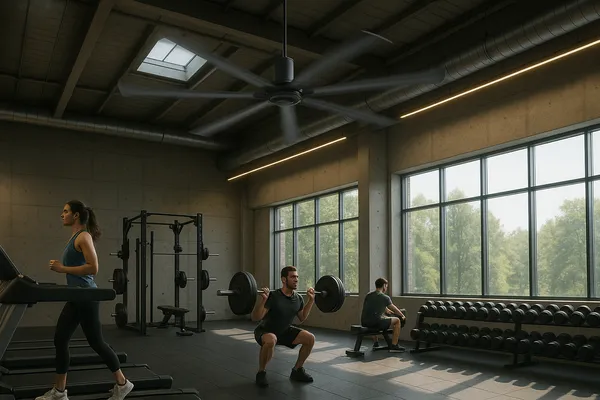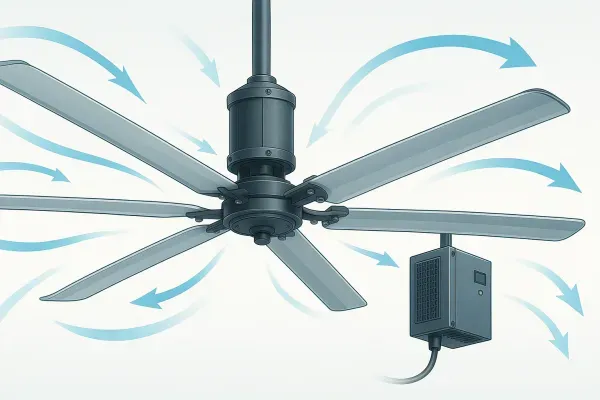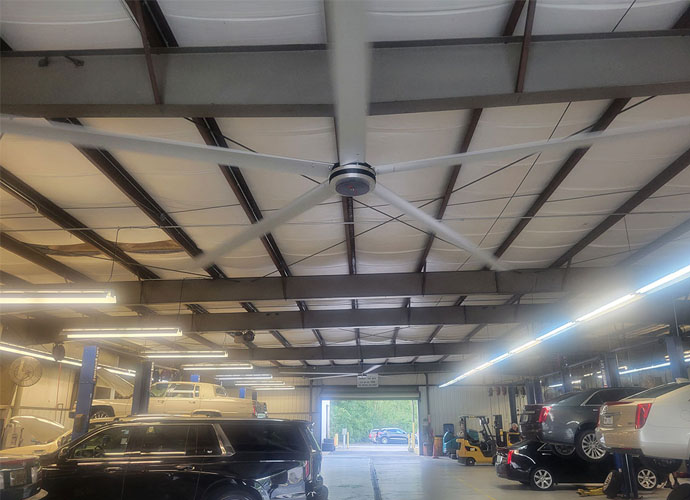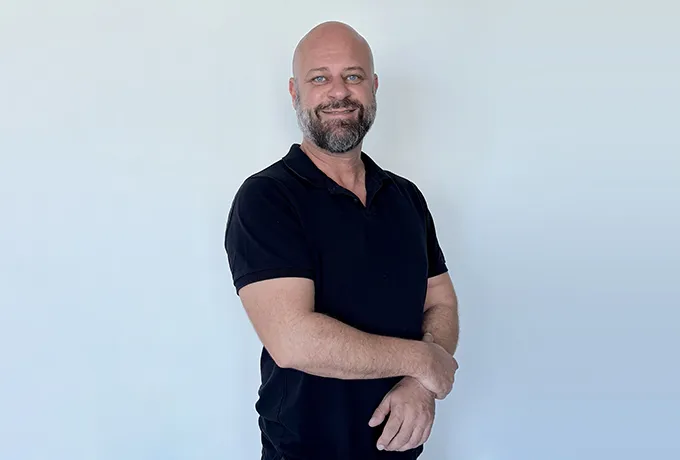Many facilities battle hot spots and harsh fan noise. That noise distracts people, lowers focus, and raises complaints. The fix is simple: pick a system that moves big air at low rpm for quiet operation—without sacrificing comfort.
The quietest industrial fan uses a large diameter and low-speed motor to push high volume air with minimal turbulence. HVLS ceiling designs spread airflow gently, keeping sound levels near 60 decibels while maintaining strong airflow for cooling and ventilation in big spaces like warehouses, gyms, and schools.
When people discuss Geräuschpegel, they usually mean sound levels measured in db. In open spaces, anything around 60 decibels feels like a normal conversation; that’s a good target for a quiet industrial choice. Going lower is even leiser, but airflow must stay adequate for comfort and Belüftung.
Noise grows with turbulence. Large, slow-moving air columns reduce mechanische Geräusche am Lüfterflügel and at the inlet ring. With the right geometry, you get steady Luftbewegung and smooth Luftstrom über die Arbeitsbereich.

The quiet industrial fans in the gym
A Deckenventilator with an HVLS layout spreads air in a wide disc, then down to the floor in an evenly distributed dual column that sweeps outward. Because the disc is großer Durchmesser, you get the same cooling effect at niedrigere Geschwindigkeiten, which helps reduce noise.
Ein Axialventilator focuses a stream; it’s great when you must Luft bewegen toward a spezifische Anwendung, like a production line. To keep a comparable comfort band over a wide area, the axial unit may need higher tip speed, which can raise Lüftergeräusch.
HVLS stands for High Volume, Low Speed (hvls). These high-performance fans spin slowly yet push a hohe Lautstärke air mass that spreads gently for efficient air mixing. The downward stream becomes a distributed dual column of air that breaks heat stratification without drafts.
Because HVLS Lüfter sind to work at low rpm, they achieve minimal energy consumption while keeping a quiet Arbeitsumgebung. In our test bay, a 6-blade unit delivered 8100 cfm at a modest rpm, right in line with a quiet low-noise fan profile.Explore example layouts in industrielle Deckenventilatoren.
First, blade planform. Smooth, Aerodynamik leading edges cut turbulence. Second, variable Geschwindigkeit drives let you tune output for conditions. Third, smart noise control from the drive and hub reduces harmonics, helping the fan quiet at steady state.
Other Lüfterfunktionen matter too: balanced rotors, isolated mounts, and optional silencer kits on ducts for Ventilatoren und Gebläse that concentrate flow. Our HVLS energy efficiency overview shows how these pieces fit together for comfort and cost.

What fan features reduce noise most effectively
Motors shape sound signatures. A dc motor—especially brushless—cuts electrical whine and ripple for leiserer Betrieb. Choice of Motortyp also affects torque at langsame Geschwindigkeit, which supports optimale Leistung without surges. With variable Geschwindigkeitsregelung, teams dial airflow for seasons or shifts.
Modern motor technology pairs with high-efficiency drives. That’s where high-efficiency components (and hohe Effizienz system design) shine: you keep comfort with less input power. Curious how controls map to real rooms? See HVLS for gyms for step-by-step tuning examples.
Right-size by purpose. For a packaging line, aim steady Luftstrom that washes over people without buffeting. In a dock door applications zone, you’ll want directional flow that blocks bugs and heat exchange. In offices near production, keep a calm Büroumgebung with gentle mixing.
Use the simple planning table below to match space types to output ranges and typical sound bands. For a deeper sizing walk-through, check our Belüftung von Lagerhallen guide built for planners.
Typical output and sound bands
| Raumtyp | Example Fan Type | Typical Output (CFM) | Typical dB at 5 m | Anmerkungen |
| Warehouse Aisle | HVLS Deckenventilator | 6,000–20,000 | ~55–62 | Mix air, combat stratification |
| Assembly Cell | Quiet Axialventilator | 2,000–8,000 | ~58–65 | Targeted stream |
| Loading Dock | Directional blower | 8,000–16,000 | ~62–70 | Push-through barrier |
| Fitness Court | HVLS ceiling (gym) | 5,000–15,000 | ~55–60 | Wide comfort zone |
| Small Shop Bench | Low-profile drum fan | 1,500–5,000 | ~58–64 | Spot cooling |
| Showroom/Office | HVLS micro | 1,000–3,000 | ~50–56 | Quiet, mixed flow |
Quiet matters, but comfort rules. Some Lüfter entworfen for spot cooling may be louder yet perfect for a welding booth. A Hochgeschwindigkeitslüfter can punch through heat plumes, while a misting fan Angebote Verdunstungskühlung outdoors.
Choose the design that fits your spezifische Anwendung and people flow. For a quick head-to-head—HVLS vs. floor or shop fan—see shop fan vs HVLS.
Yes. When you slow the blade and grow the disc, you move the same comfort air with minimal energy consumption. That’s the core of “low speed, big disc.” It’s why fans deliver steady comfort and remain energieeffizient—even at partial loads.
Well-tuned systems cut runtime and cost. Our plant’s field data shows double-digit savings after upgrading controls and setpoints. Explore the numbers and settings in HVLS energy efficiency.
Not every space fits a jumbo rotor. In low-ceiling areas, consider compact HVLS or a low-profile unit. In tight aisles, directed streamers manage hot spots without drafts. In reception or a home office adjacent to production, micro-HVLS keeps comfort without fan roar.
Outdoors or mezzanines? Think airflow paths, returns, and obstructions. Our team maps flow lines before install.

Selecting for low ceilings, tight aisles, and special zones
We build and test Lüfter sind for big rooms that need calm air. In one gym retrofit, Fans bieten steady mixing that members immediately noticed: “The room feels cooler, but I don’t hear a thing.” In a pallet warehouse, two lanes near docks stayed comfortable with lower rpm and a small control tweak.
Because we’re a Schwerlast producer, we validate against osha guidance to avoid hearing damage, and we check product safety pathways toward ul listing. That’s standard practice for our factory partners in globally certified supply chains.
“We installed three HVLS units above courts and asked players to rate noise. Average score: ‘can’t hear it,’ while comfort shot up.”
Case Snapshot A — Warehouse (8,000 m²)
Case Snapshot B — Gym & Courts
Decibel limits vary by exposure time. The farther above speech you go, the faster fatigue grows. Follow your safety plan to keep the mix restful and safe.
Sound and exposure basics
| A-weighted Level | Rough Comparison | Typical Max Exposure* |
| 60 dB | normal conversation | 16+ hours |
| 70 dB | car at 25 ft | 8 hours |
| 80 dB | shop floor, loud zone | 2–4 hours |
*Always follow your safety team’s policy.
A mid-bay HVLS unit can move strong airflow at low rpm. At 35% speed, one of our hohe Geschwindigkeit test units still delivered 8100 cfm into a broad zone. That mix keeps operators cool and parts stable for QC.
For door lines, combine directed streamers and HVLS. That hybrid plan calms edges while the big disc maintains the middle. If you’re planning a multi-zone floor, our Belüftung von Lagerhallen note shows typical layouts.
Axials excel in filtration loops and paint booths. Pair them with a short duct and a clean inlet grid; the smoother the transition, the less hiss. For exhausts, a compact shell with a lined bend acts like a silencer.
Remember, fans deliver best results when sized to static pressure. Use actual bends and fittings in your model, and keep maintenance simple. Our axial fan basics page lists common setups.
Controls decide comfort. With variable Geschwindigkeitsregelung, supervisors nudge setpoints to keep people happy without overshoot. That’s where smart drives unlock savings and comfort at once.
Safety stays first. We check mounting, anchors, guards, and procedures on every job. Reference your own program and align selections with site rules. A calm, safe Arbeitsumgebung beats any paper spec.
A wheeled drum fan gives temporary relief for curing or cleanup. Where humidity is low, a misting fan adds Verdunstungskühlung on patios and sidings. Use it outside or in areas meant for moisture.
In showrooms, small HVLS creates gentle Luftzirkulation without drafts. It’s a good fit when people meet, demo, and walk between displays.
Target Rauschunterdrückung first, then confirm capacity.
Lock your airflow model—room size, loads, and Luftstrom path.
Bestätigen motor technology and controls you can actually use.
Check safety, guards, and policy.
Plan maintenance and cleaning.
Document results and keep tuning.
If you’d like help mapping your floor, reach out for a layout and a costed bill. We’ll tailor options to your goals and budget.
What makes an industrial fan quiet in real use?
Large rotors at niedrigere Geschwindigkeiten, smooth edges, and tuned controls. That combo softens turbulence and keeps noise low while still moving the air you need.
Can a quiet fan still cool effectively?
Yes. HVLS spreads comfort with a slow, wide disc. It feels cooler because it mixes air evenly across people and machines.
How do I avoid noisy installs near offices?
Use isolation mounts, duct radius guidelines, and slow-ramp control. In an adjacent Büroumgebung, micro-HVLS often fits best.
Will high output always mean high noise?
No. With the right rotor and layout, you can get hohe Geschwindigkeit effects quietly. Choose geometry first, then size power.
Do I need certification and safety checks?
Follow your plant’s policy and look for third-party paths like ul. Keep exposure below policy limits to avoid hearing damage.
Are these systems only for factories?
No. They’re common in Fitnessstudios, Schulen, kommerziell spaces, and more. They adapt to many uses and seasons.

Hallo, ich bin Michael Danielsson, CEO von Vindus Fans, mit über 15 Jahren Erfahrung in der Ingenieur- und Designbranche. Ich bin hier, um mein Wissen weiterzugeben. Wenn Sie Fragen haben, können Sie mich jederzeit kontaktieren. Lassen Sie uns gemeinsam wachsen!